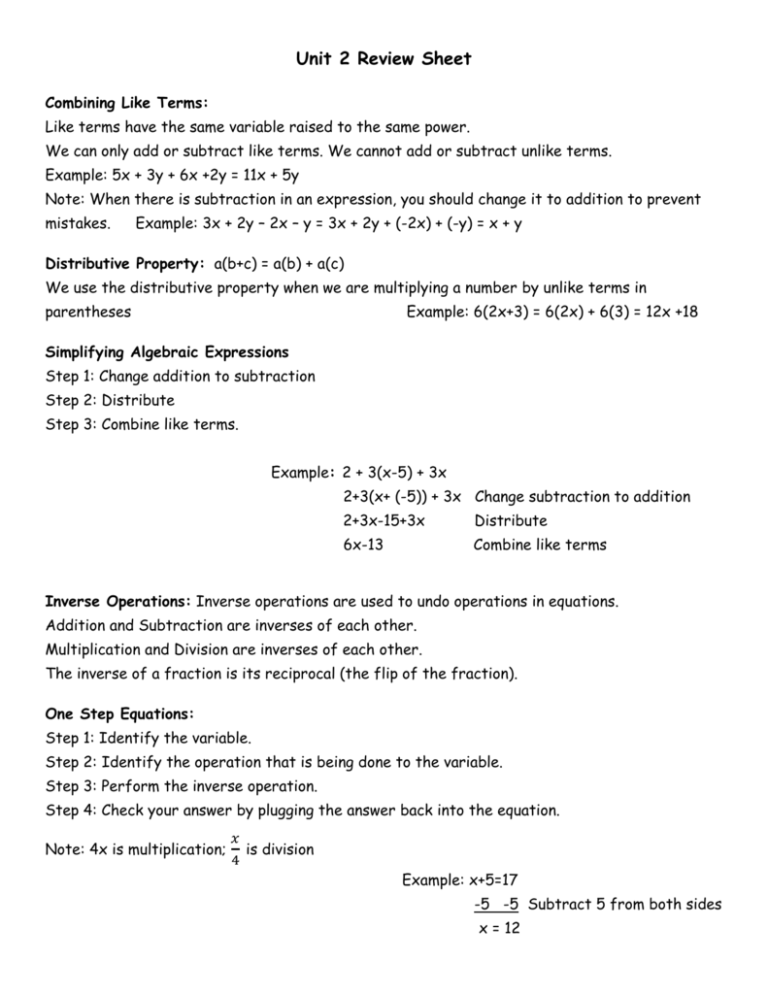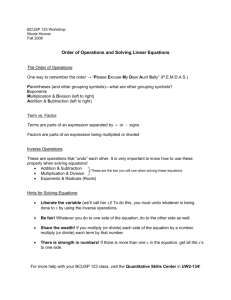Unit 2 Study Guide
advertisement

Unit 2 Review Sheet Combining Like Terms: Like terms have the same variable raised to the same power. We can only add or subtract like terms. We cannot add or subtract unlike terms. Example: 5x + 3y + 6x +2y = 11x + 5y Note: When there is subtraction in an expression, you should change it to addition to prevent mistakes. Example: 3x + 2y – 2x – y = 3x + 2y + (-2x) + (-y) = x + y Distributive Property: a(b+c) = a(b) + a(c) We use the distributive property when we are multiplying a number by unlike terms in parentheses Example: 6(2x+3) = 6(2x) + 6(3) = 12x +18 Simplifying Algebraic Expressions Step 1: Change addition to subtraction Step 2: Distribute Step 3: Combine like terms. Example: 2 + 3(x-5) + 3x 2+3(x+ (-5)) + 3x Change subtraction to addition 2+3x-15+3x Distribute 6x-13 Combine like terms Inverse Operations: Inverse operations are used to undo operations in equations. Addition and Subtraction are inverses of each other. Multiplication and Division are inverses of each other. The inverse of a fraction is its reciprocal (the flip of the fraction). One Step Equations: Step 1: Identify the variable. Step 2: Identify the operation that is being done to the variable. Step 3: Perform the inverse operation. Step 4: Check your answer by plugging the answer back into the equation. Note: 4x is multiplication; 𝑥 4 is division Example: x+5=17 -5 -5 Subtract 5 from both sides x = 12 Two Step Equations Solve equations by undoing operations in the opposite order of PEMDAS. Step 1: Identify the variable. Step 2: Identify any addition or subtraction that is being done to the variable. Step 3: Perform the inverse operation. Step 4: Identify any multiplication or division that is being done to the variable. Step 5: Perform the inverse operation. Step 6: Check your answer by plugging it back into the equation. Example: 5x + 8 = 28 -8 -8 Subtract 8 5x=20 x=4 Divide by 5 Multi Step Equations Step 1: Simplify both sides of the equation by distributing and combining like terms. Step 2: Solve the equation the same way you would solve a two step equation. Distributing Fractions in Equations Method One: Multiply both sides by the reciprocal. Method Two: Multiply both sides by the least common denominator. Note: You must always get rid of anything being adding or subtracted to the variable before multiplying by the reciprocal or LCD. Translating Words to Expressions: Break apart the words to write them as a mathematical expression. Less than: switch the order of the numbers Subtracted from: switch the order of the numbers Algebraic Equations (word problems): Step 1: Identify the variable. Step 2: Write an equation. Step 3: Solve and check. Step 4: Label your answer Inequalities > greater than (x>2 means any number larger than two is a solution) < less than (x<2 means any number smaller than two is a solution) > greater than or equal to (x>2 means that two and any number larger than two is a solution) < less than or equal to (x<2 means that two and any number smaller than two is a solution) Graphing Inequalities An open circle is used when the number is not a solution (greater than/less than) A closed circle is used when the number is a solution (greater than or equal to/less than or equal to) If the variable is on the left, the inequality symbol points in the direction that the arrow of the graph should go. Solving Inequalities Use the same rules that we use for solving equations, except if you multiply or divide by a negative, you must flip the sign of the inequality.










